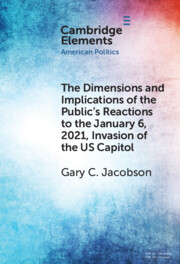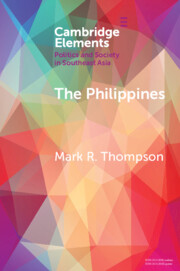108 results
12 - Environmental Displacement and Political Violence
- from Part III - Environmental Violence Impacts, Responses, Resistance, and Alternatives
-
-
- Book:
- Exploring Environmental Violence
- Print publication:
- 30 June 2024, pp 261-277
-
- Chapter
-
- You have access
- Open access
- HTML
- Export citation
What are the limits of political violence? Ebihara Toshio’s murder and the Umemoto-Kuroda controversy in 1970s Japan
-
- Journal:
- Modern Asian Studies , First View
- Published online by Cambridge University Press:
- 02 May 2024, pp. 1-26
-
- Article
- Export citation

The Dimensions and Implications of the Public's Reactions to the January 6, 2021, Invasion of the U.S. Capitol
-
- Published online:
- 29 March 2024
- Print publication:
- 25 April 2024
-
- Element
- Export citation
Violence, Predation, and FDI Entry
-
- Journal:
- Business and Politics / Volume 26 / Issue 1 / March 2024
- Published online by Cambridge University Press:
- 21 February 2024, pp. 47-63
-
- Article
-
- You have access
- Open access
- HTML
- Export citation
Chapter 34 - Case Study 1: The Omagh Bomb, the Mental Health Response, and the Lessons Learned
- from Section 4 - Responses to Meet the Mental Health Needs of People Affected by Emergencies, Major Incidents, and Pandemics
-
-
- Book:
- Major Incidents, Pandemics and Mental Health
- Published online:
- 11 January 2024
- Print publication:
- 01 February 2024, pp 252-256
-
- Chapter
- Export citation
1 - Introduction to the Book
-
- Book:
- When Politics Becomes Personal
- Published online:
- 04 January 2024
- Print publication:
- 18 January 2024, pp 1-9
-
- Chapter
- Export citation
6 - 1860: The Undisputed Election that Sparked Dispute
- from Part II - Evolutions
-
- Book:
- Born in Blood
- Published online:
- 18 January 2024
- Print publication:
- 18 January 2024, pp 132-156
-
- Chapter
- Export citation
5 - The Time of War
-
- Book:
- The Time of Global Politics
- Published online:
- 23 November 2023
- Print publication:
- 07 December 2023, pp 143-167
-
- Chapter
- Export citation
29 - Nationalism, Terrorism, and the State: Historical Perspectives
- from Part III - Intersections: National(ist) Synergies and Tensions with Other Social, Economic, Political, and Cultural Categories, Identities, and Practices
-
-
- Book:
- The Cambridge History of Nationhood and Nationalism
- Published online:
- 08 November 2023
- Print publication:
- 09 November 2023, pp 619-639
-
- Chapter
- Export citation
Political violence and financial markets in Tsarist Russia
-
- Journal:
- Financial History Review / Volume 30 / Issue 2 / August 2023
- Published online by Cambridge University Press:
- 06 October 2023, pp. 231-275
-
- Article
-
- You have access
- Open access
- HTML
- Export citation
Sorry for what? Asking the right questions about the Bangladeshi liberation war and Pakistan's genocidal military operation in 1971 – ERRATUM
-
- Journal:
- Journal of the Royal Asiatic Society / Volume 33 / Issue 4 / October 2023
- Published online by Cambridge University Press:
- 27 October 2023, p. 899
- Print publication:
- October 2023
-
- Article
-
- You have access
- HTML
- Export citation
8 - Narratives and Voices of Cultural Revolution “Perpetrators”
- from Part IV - Memory
-
-
- Book:
- Justice After Mao
- Published online:
- 31 August 2023
- Print publication:
- 14 September 2023, pp 193-215
-
- Chapter
- Export citation
Tinker, Tailor, Soldier, Informer: Revisiting the Ethics of Espionage in the Context of Insurgencies and New Wars
-
- Journal:
- Ethics & International Affairs / Volume 37 / Issue 2 / Summer 2023
- Published online by Cambridge University Press:
- 29 August 2023, pp. 134-146
-
- Article
-
- You have access
- Open access
- HTML
- Export citation
6 - Judicial Constructions of the Refugee Convention Reasons for Persecution in Situations of Contemporary Armed Conflict
-
- Book:
- Conflict Refugees
- Published online:
- 20 July 2023
- Print publication:
- 10 August 2023, pp 103-125
-
- Chapter
- Export citation
Sorry for what? Asking the right questions about the Bangladeshi liberation war and Pakistan's military operation in 1971
-
- Journal:
- Journal of the Royal Asiatic Society / Volume 33 / Issue 4 / October 2023
- Published online by Cambridge University Press:
- 03 August 2023, pp. 871-897
- Print publication:
- October 2023
-
- Article
- Export citation
Beyond the Gonzalo Mystique: Challenges to Abimael Guzmán’s Leadership inside Peru’s Shining Path, 1982–1992
-
- Journal:
- Latin American Research Review / Volume 58 / Issue 4 / December 2023
- Published online by Cambridge University Press:
- 05 June 2023, pp. 743-761
-
- Article
-
- You have access
- Open access
- HTML
- Export citation

The Philippines
- From ‘People Power’ to Democratic Backsliding
-
- Published online:
- 11 May 2023
- Print publication:
- 25 May 2023
-
- Element
- Export citation
Terrified or Enraged? Emotional Microfoundations of Public Counterterror Attitudes
-
- Journal:
- International Organization / Volume 77 / Issue 4 / Fall 2023
- Published online by Cambridge University Press:
- 03 November 2023, pp. 824-847
- Print publication:
- Fall 2023
-
- Article
-
- You have access
- Open access
- HTML
- Export citation
2 - The Field
- from Part I - Theory and Ethnography
-
- Book:
- State-Building as Lawfare
- Published online:
- 02 February 2023
- Print publication:
- 09 February 2023, pp 59-96
-
- Chapter
- Export citation
1 - Political Violence and the Amendolas, Father and Son
-
- Book:
- Politics, Murder and Love in an Italian Family
- Published online:
- 13 January 2023
- Print publication:
- 09 February 2023, pp 4-32
-
- Chapter
- Export citation



